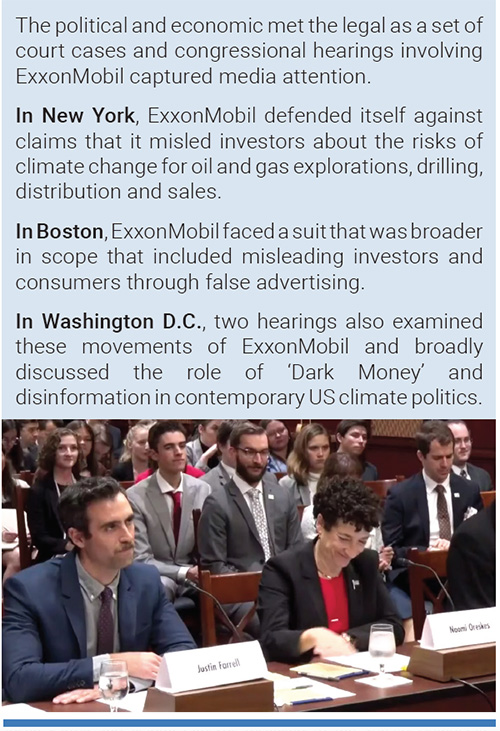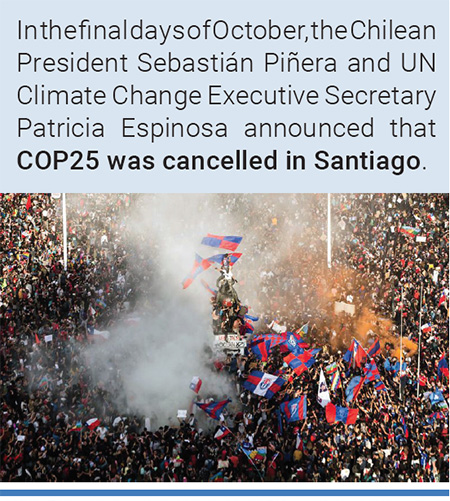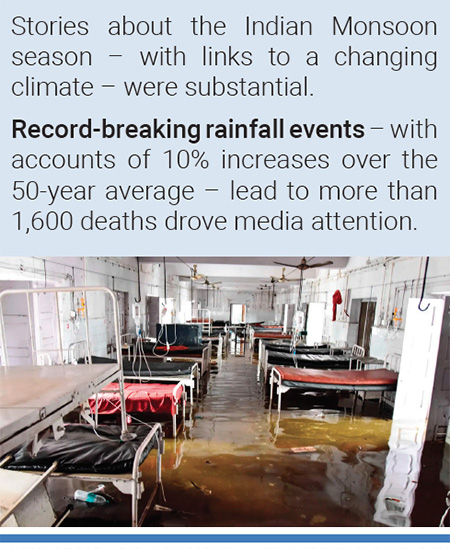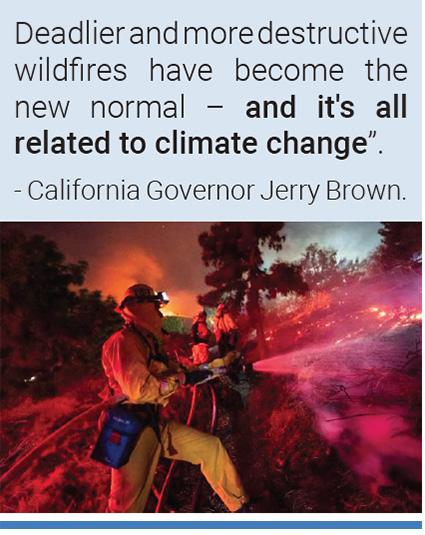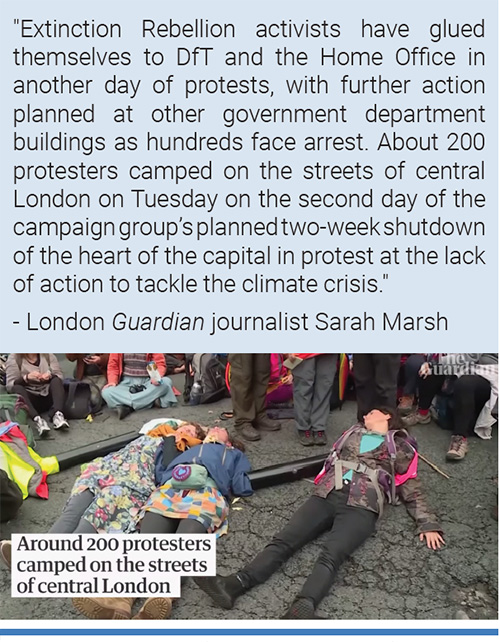Monthly Summaries
Issue 34, October 2019
[DOI]

Fire is seen near Getty Center in Los Angeles on October 28, 2019. Photo: Qian Weizhong/Getty Images.
October media attention to climate change and global warming went down 8% from record levels of coverage in September 2019. However, it was still up 48% throughout the world from October 2018. While Middle East and North America coverage was up 10% and 7% respectively from the previous month, it was down in all other regions. At the country level, coverage also dropped from high levels in September in all countries we monitor, with the exception of increases in three countries: the United Kingdom (+8%), New Zealand (+5%) and Canada (+49%).
In particular, New Zealand’s record September 2019 coverage followed by continued 5% increase in October 2019 showed sustained media discussions of climate change and global warming.

Figure 1. Number of news stories per day per outlet in October 2019 across the New Zealand newspapers The New Zealand Herald, The Dominion Post, and The Press.
In October 2019, Canadian coverage of climate change indeed went up 49% from the previous month of September 2019. Canadian coverage also reached record levels, and this was largely attributed to the role that climate change played in the October 21 General Election for Prime Minister (see Figure 2). For example, journalist Chris Turner reporting for the Globe & Mail noted, “Climate change has never before played as central a role in a Canadian federal election as it did this year, and Mr. Trudeau ran hard on his record as the only leader offering both credible action on climate change and continued support for Canada’s oil and gas sector. The Liberals were, as Mr. Trudeau once put it, the only ones who saw both pipelines and wind turbines in Canada’s energy future. This was Mr. Trudeau’s grand climate bargain – better market access for oil and gas in a sort of trade for consensus on a workable path to a low-carbon economy – and Canadians have given him a shot at seeing that bargain through. I’d argue his legacy as a Prime Minister will ultimately rest on whether he can deliver on it. Mr. Trudeau’s reference to a referendum on the next 40 years was not self-aggrandizing on the climate front”. Meanwhile, over at The Toronto Star journalists Peter Lowen and Michael Bernstein reported after the election that “voters who turned away from the federal Conservatives were overwhelmingly concerned about climate change. Of the voters who did not vote for Scheer’s Conservatives, 20 per cent said they would have considered supporting the party. Among this Conservative-friendly pool of available voters, 77 per cent said climate change was among their top voting issues. Those same voters were unimpressed with the Conservative platform on climate change, giving it an average grade of D. What those results tell us is that the Conservatives left thousands of votes on the table, especially in battleground regions like Toronto and the 905 belt around Canada’s largest city. Had those people switched their vote to the Conservatives, we might be looking at a very different government today. If Conservatives are going to win elections in the future, they will need to advance a more credible plan on climate change — and that begins with not only accepting, but embracing, the reality of the carbon tax and rebate”.

Figure 2. Number of news stories per day per outlet in October 2019 across the Canadian newspapers Globe & Mail, The Toronto Star and The National Post.
Figure 3 shows trends in newspaper media coverage at the global scale – organized into seven geographical regions around the world – from January 2004 through October 2019.

Figure 3. Newspaper media coverage of climate change or global warming in one hundred sources in seven different regions around the world, from January 2004 through October 2019.
This month, we integrate 17 new sources across 14 countries: five new sources in Asia, 11 new sources in Africa and 1 new source in the Middle East. These are:
- The Malaysian Reserve (Malaysia), Today (Singapore), The Daily Mirror (Sri Lanka), The Daily News (Sri Lanka) and The New Nation (Bangladesh) in Asia;
- Daily Trust (Nigeria), Vanguard (Nigeria), The New Times (Rwanda), Daily Nation (Kenya), The Times of Zambia (Zambia), New Era Namibia (Namibia), The Citizen (Tanzania), Le Potentiel (Congo), L’Observateur Paalga (Burkina Faso), La Nouvelle Tribune (Morocco) and Sud Quotidien (Senegal) in Africa;
- Dawn (Pakistan) in the Middle East.
 This work increases our explanatory power regarding print media coverage of climate change in these regions now with 23 sources in Asia, 15 sources in Africa and 6 sources in the Middle East along with 20 sources in North America, 13 sources in Latin America, 8 sources in Oceania and 28 sources in Europe. This brings the number of print sources that our Media and Climate Change Observatory (MeCCO) monitor up to 100 sources across 54 countries. Including television and radio with newspaper sources, we at MeCCO now monitor 113 sources total across 55 countries. (For more details about each source, visit our ‘Source Fact Sheet’ page on the MeCCO website.
This work increases our explanatory power regarding print media coverage of climate change in these regions now with 23 sources in Asia, 15 sources in Africa and 6 sources in the Middle East along with 20 sources in North America, 13 sources in Latin America, 8 sources in Oceania and 28 sources in Europe. This brings the number of print sources that our Media and Climate Change Observatory (MeCCO) monitor up to 100 sources across 54 countries. Including television and radio with newspaper sources, we at MeCCO now monitor 113 sources total across 55 countries. (For more details about each source, visit our ‘Source Fact Sheet’ page on the MeCCO website.
This month, further political and economic connections with climate issues dominated media coverage around the world. For example, October began with discussions emanating from an International Monetary Fund (IMF) about putting a price on carbon. The IMF proposed that funds gathered through the pricing scheme would be dedicated to offset increases in energy prices. The report also posited that implementation of a $75 per ton tax on carbon by 2030 could keep warming to 2 degrees C. The IMF prognosticated that it would also lead to approximately 30% greenhouse gas (GHG) emissions reductions in the United States (US) and up to 45% GHG emissions reductions in China, India and other developing nations. This set of IMF pronouncements signaled further acceptance of carbon pricing in business and finance communities as a tool to effectively combat climate change.
Consequently, this report generated substantial media attention. For example, CNBC reporter Emma Newburger reported, “Increasing the price of carbon is the most efficient and powerful method of combating global warming and reducing air pollution, according to a new report from the International Monetary Fund. While the idea of carbon taxes on fossil fuel corporations has been spreading across the globe in the past couple decades, increasing prices on carbon emissions has received widespread backlash from those who argue the tax would raise energy bills. But economists have long contended that raising the cost of burning fossil fuels like coal, oil and gas is the best way to mitigate climate change, and that revenue raised from the tax can be returned to consumers through rebates and dividends”.
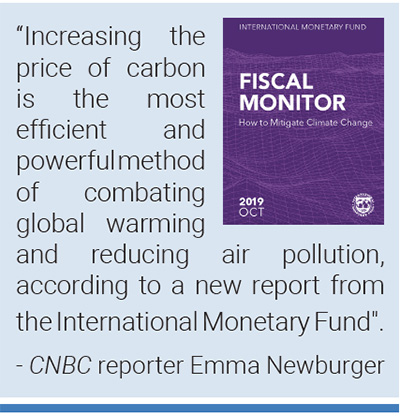 Meanwhile, Washington Post journalists Chris Mooney and Andrew Freedman wrote, “A global agreement to make fossil fuel burning more expensive is urgent and the most efficient way of fighting climate change, an International Monetary Fund study found on Thursday. The group found that a global tax of $75 per ton by the year 2030 could limit the planet’s warming to 2 degrees Celsius (3.6 degrees Fahrenheit), or roughly double what it is now. That would greatly increase the price of fossil-fuel-based energy — especially from the burning of coal — but the economic disruption could be offset by routing the money raised straight back to citizens ... The IMF report comes out as financial institutions increasingly grapple with the risks associated with climate change, including damage from sea-level rise, extreme weather events and billions in fossil fuel reserves that might be in excess of what can be burned while also limiting warming. The Federal Reserve, for example, is taking a closer look at how climate change may pose a risk to economic stability. In the United States, a $75 tax would cut emissions by nearly 30 percent but would cause on average a 53 percent increase in electricity costs and a 20 percent rise for gasoline at projected 2030 prices, the analysis in the IMF’s Fiscal Monitor found. But it would also generate revenue equivalent to 1 percent of gross domestic product, an enormous amount of money that could be redistributed and, if spread equally, would end up being a fiscally progressive policy, rather than one disproportionately targeting the poor. The impact of a $75-per-ton tax would also hit countries differently depending on burning or exporting coal, which produces the most carbon emissions per unit of energy generated when it is burned. In developing nations such as China, India and South Africa, a $75 carbon tax reduces emissions even more — by as much as 45 percent — and generates proportionately more revenue, as high as 3.5 percent of GDP in South Africa’s case, the IMF found”.
Meanwhile, Washington Post journalists Chris Mooney and Andrew Freedman wrote, “A global agreement to make fossil fuel burning more expensive is urgent and the most efficient way of fighting climate change, an International Monetary Fund study found on Thursday. The group found that a global tax of $75 per ton by the year 2030 could limit the planet’s warming to 2 degrees Celsius (3.6 degrees Fahrenheit), or roughly double what it is now. That would greatly increase the price of fossil-fuel-based energy — especially from the burning of coal — but the economic disruption could be offset by routing the money raised straight back to citizens ... The IMF report comes out as financial institutions increasingly grapple with the risks associated with climate change, including damage from sea-level rise, extreme weather events and billions in fossil fuel reserves that might be in excess of what can be burned while also limiting warming. The Federal Reserve, for example, is taking a closer look at how climate change may pose a risk to economic stability. In the United States, a $75 tax would cut emissions by nearly 30 percent but would cause on average a 53 percent increase in electricity costs and a 20 percent rise for gasoline at projected 2030 prices, the analysis in the IMF’s Fiscal Monitor found. But it would also generate revenue equivalent to 1 percent of gross domestic product, an enormous amount of money that could be redistributed and, if spread equally, would end up being a fiscally progressive policy, rather than one disproportionately targeting the poor. The impact of a $75-per-ton tax would also hit countries differently depending on burning or exporting coal, which produces the most carbon emissions per unit of energy generated when it is burned. In developing nations such as China, India and South Africa, a $75 carbon tax reduces emissions even more — by as much as 45 percent — and generates proportionately more revenue, as high as 3.5 percent of GDP in South Africa’s case, the IMF found”.
In later October, the political and economic met the legal as a set of court cases and congressional hearings involving ExxonMobil and climate change captured media attention. The events that captured media coverage took place in New York, Boston and in Washington D.C. In New York, ExxonMobil defended itself against claims that it misled investors about the risks of climate change for oil and gas explorations, drilling, distribution and sales. In Boston, ExxonMobil faced a suit that was broader in scope that included misleading investors and consumers through false advertising. In Washington D.C., two hearings – one through the House Oversight Committee and a second through the Senate Democrats’ Special Committee on the Climate Crisis – also examined these movements of ExxonMobil. In addition, these hearings more broadly discussed the role of ‘Dark Money’ (covert contributions made from fossil fuel industry groups to organizations that sought to slow or stop climate policy action) and disinformation in contemporary US climate politics.
Justin Farrell and Naomi Oreskes testifying to the Senate Democrats' Special Committee on the Climate Crisis hearing on October 29, 2019. |
Media coverage of these hearings abounded, particularly in US and UK sources. For an example of coverage surrounding the New York State court case, Wall Street Journal journalist Corinne Ramey penned a story entitled ‘Exxon Misled Investors Over Climate Change, Court Told’. She reported, “To illustrate how Exxon Mobil Corp. allegedly deceived investors about its climate-change accounting, a lawyer from the New York attorney general’s office showed a packed Manhattan courtroom Tuesday a multicolored world map the company presented to shareholders. In red were countries including the U.S. and Canada where Exxon said it was planning for tougher climate-change regulation, showing the number the company used to calculate the higher cost”. For an example of coverage of US House hearings regarding ExxonMobil, disinformation and climate change, US-based Guardian journalist Emily Holden authored an article entitled, ‘Exxon sowed doubt about climate crisis, House Democrats hear in testimony’. She began the article by writing that the House Oversight “Subcommittee laid out four decades of evidence just a day after oil behemoth began a trial over misleading investors”. She continued, “House Democrats on Wednesday laid out four decades of evidence that oil behemoth Exxon knew since the 1970s that the burning of fossil fuels was heating the planet and intentionally sowed doubt about the climate crisis. The testimony came in a hearing in a House oversight subcommittee on civil rights just a day after ExxonMobil began a trial in New York City over misleading investors on the business risks from government rules meant to address the climate crisis. Exxon’s role in hiding the mounting emergency has been widely publicized for four years, since the publication of an investigation by InsideClimate News, the Los Angeles Times and the Columbia Journalism School. Court proceedings and additional reporting have found more proof of Exxon’s longtime knowledge of the problem”.
Then in the final days of October, the Chilean President Sebastián Piñera and the United Nations (UN) Climate Change Executive Secretary Patricia Espinosa announced that the 25th Conference of Parties meeting (COP25) to the UN Framework Convention on Climate Change was cancelled in Santiago. This cancellation was due to the unrest in the country emanating from chronic inequality but sparked by a metro far hike. In early October, the Chilean government declared a state of emergency. COP25 was a highly anticipated event scheduled for the following month of December to refine a transparency framework for intended nationally determined contributions (INDCs), to further plan for Green Climate Fund contributions and to make further decisions on mitigation and adaptation actions via considerations of gender and empowerment/justice among a host of important agenda items.
Media attention was paid to these developments. For examples, BBC reporter David Shukman noted, “Chile has pulled out of hosting two major international summits, including a UN climate change conference, as anti-government protests continue. President Sebastián Piñera said the decision had caused him "pain" but his government needed "to prioritize re-establishing public order". The COP25 climate summit was scheduled for 2 to 13 December, while the APEC [Asia-Pacific Economic Cooperation] trade forum was next month. The UN said it was now looking at alternative venues. World leaders were to gather at this year's Conference of the Parties (COP) to discuss the implementation of the Paris Accord - a landmark international climate agreement, first signed at COP21 in December 2015. This is the first time a country has pulled out of hosting the conference at such short notice. The demonstrations were originally triggered by a now-suspended rise in the price of metro fares in Santiago. However protesters are now marching to express their discontent over a wide variety of problems ranging from inequality to the high cost of healthcare”. Meanwhile, New York Times journalists Ernesto Londoño and Somini Sengupta reported, “President Sebastián Piñera of Chile said on Wednesday that his country, which has been rocked by a wave of recent protests, was not in a position to host a key United Nations climate change meeting and a major Asia-Pacific trade summit later this year. The announcements underscored how destabilizing the protests and acts of vandalism have been for the country, which has long been regarded as an exemplar of stability in a tumultuous region”.
People gathered on the streets of Santiago, Chile, on October 29 to protest against government policies and economic inequality. Photo: Alberto Valdes/EPA-EFE/Shutterstock. |
Ecological and meteorological content also shaped media coverage in October. Of note, stories about the Indian Monsoon season – with links to a changing climate – were substantial. Record-breaking rainfall events – with accounts of 10% increases over the 50-year average – leading to more than 1,600 deaths drove media attention. For example, Hindustan Times journalist Jayashree Nanda reported, “The behaviour of this year’s monsoon is getting curiouser and curiouser — after beginning to withdraw only on October 9, well after the usual date of September 1, the latest withdrawal since at least 1961, it has, in the span of five days, retreated from most parts of the country and, in the next few days, will be gone completely, according to the India Meteorological Department (IMD). In other words, it will take a week to do what it usually does over 45 days. But that is perhaps only to be expected of what has been a very peculiar monsoon characterised by a delayed onset, an extremely dry June, a near deluge in several states in August and September, and, of course, a delayed withdrawal”. Looking to the future, journalist Jasjeev Gandhiok from The Times of India linked the monsoons to climate change in an article entitled ‘Extremely Hot Days May Go Up 22 Times in Delhi by 2100’. He noted, “While the capital on an average records three extremely hot days as of now, future citizens will have to suffer for as many as 67 days every year. On an extremely hot day, temperatures could remain over 35 degrees Celsius throughout the day”.
Meanwhile, reporting for The Guardian from Delhi, journalist Rebecca Ratcliffe noted, “More than 100 people have died in flooding in the Indian states of Bihar and Uttar Pradesh, where vast areas have been inundated by delayed monsoon rains. Videos shared on social media show submerged roads and heavy flooding at one of the major hospitals in Patna, state capital of Bihar, where patients lay on beds just inches above dirty water. Schools and offices are closed in many areas, and electricity supplies for some residents cut to one hour a day to prevent accidents. In Uttar Pradesh, 93 people have died due to the incessant rains, which has caused homes to collapse and led to an increase in snake bites. Dozens of people have also died in Bihar, where boats have been deployed to rescue stranded residents. Experts blame a lack of urban planning and poor drainage systems, which have been unable to cope with sudden and incessant rains over recent days”.
A waterlogged ward in a hospital in Patna, capital of Bihar, after vast areas of the state were inundated by delayed monsoon rains. Photo: Sachin Kumar/AFP/Getty Images. |
Also in October, Hurricane Lorenzo visited the United Kingdom (UK) and Ireland. The hurricane was downgraded to a storm by the time it reached Ireland and the UK. Nonetheless, the storm earned a good amount of media attention. For example, Associated Press journalist Barry Hatton noted, “Hurricanes the size of Lorenzo are rare so far north and east in the Atlantic basin. Lorenzo is producing huge swells across the North Atlantic as it moves northeast toward Ireland and the United Kingdom and weakens to a Category 1 hurricane”. As a second example, journalist Matthew Cappucci from The Washington Post reported, “Former Hurricane Lorenzo is now “Storm Lorenzo,” named by the Irish Meteorological Service as the powerful tempest approaches. Winds as high as 80 mph, localized flooding and travel disruptions are all anticipated as the post-tropical cyclone gets set to make landfall in Europe. With forward speeds topping 45 mph, Storm Lorenzo is cruising — enough so that the worst of the weather will only occur over a 9 to 12 hour period. For Ireland, the roughest was expected from dinner time on Thursday overnight into early Friday morning. A 63 mph wind gust was measured by an offshore weather buoy 300 miles west of Ireland situated over Northeast Atlantic’s Rockall Trough. Air pressure at that buoy dropped to 28.63 inches — down from more than 30 inches — indicating how efficiently the storm is evacuating air upward and outward. That powerful drop in air pressure creates a vacuum effect, drawing in air from all around and spurring the strong winds associated with Storm Lorenzo. That air pressure is commensurate with what’s seen in many Category 2 hurricanes”.
In mid-October, Typhoon Hagabis struck Japan. Considerable coverage domestically and abroad made links between extreme events and a changing climate. For example, New York Times journalists Motoko Rich and Ben Dooley reported, “Japan woke on Sunday morning to flooded rivers and burst levees, as emergency workers used helicopters and boats to rescue stranded residents from their homes in the wake of Typhoon Hagibis, the largest storm to hit the country in decades. Rain began falling on Saturday and continued through Sunday morning, testing dams, pulling down hillsides, destroying roads and bridges, and driving rivers over their banks ... Kenichi Nakajima, 58, a farmer, had driven over a bridge to see the flooding close to a friend’s house. “They can’t get out of their houses; it’s such a pity,” he said. “We don’t have supermarkets around here. We have to go far to a big supermarket. But without a car, we can’t go shopping as the cars are flooded.” The scale of the damage was “abnormal,” Mr. Nakajima said, suggesting global warming was responsible. “Recently, a girl made a speech about global warming, and as she was crying she said, ‘We have no future,’” he said, referring to the climate activist Greta Thunberg. “She is absolutely right.”
Ongoing fires through California in the US also generated media attention that made links between these fires and a changing climate. For example, New York Times journalists Thomas Fuller and Tim Arango noted, “the area burned by fires each year in the summer months has increased drastically, and this is consistent with the influence expected from global warming”. Furthermore, CNN journalists Ray Sanchez and Brandon Miller noted, “More than a dozen wildfires displace hundreds of thousands of Californians. Nearly 30 million people from California to Arizona wake up to red-flag warnings that signal conditions ripe for fire danger. Utilities throw entire communities into darkness in hopes of reducing the risks. More than 94,000 acres have already burned. Vast forests of dead trees have become tinderboxes. In South Orange [County], Deborah Engel is investing in her local community to change the landscape for working parents. "This is only the beginning," former California Gov. Jerry Brown told Politico this week. "This is only a taste of the horror and terror that will occur in decades." But it's happening now. Here's why deadlier and more destructive wildfires have become the new normal – and it's all related to climate change”.
Firefighters work near the Getty Center in Los Angeles on Monday, October 28. Photo: Getty Images. |
In October, cultural dimensions of climate change and global warming captured media attention as well. For example, increased Extinction Rebellion actions across the US and UK garnered coverage. To illustrate, in Chicago USA Today journalist Grace Hauck reported, “About 200 protesters marched through downtown Chicago Monday evening to demand lawmakers declare a climate emergency. The group initially rallied at a main downtown plaza across from City Hall, where they hosted speakers and cheered on a simultaneous student protest. Meanwhile, around two dozen Chicago-area teens dressed in all black gathered across from Trump International Hotel and marched to City Hall, where they staged an 11-minute "die-in." During the demonstration, the teens laid on the ground in silence, many with their palms facing up, revealing phrases such as "climate emergency" written in red paint”.
As a second example, in London Guardian journalist Sarah Marsh observed, “Extinction Rebellion activists have glued themselves to the Department for Transport and the lobby of the Home Office in another day of protests, with further action planned at other government department buildings as hundreds face arrest. About 200 protesters camped on the streets of central London on Tuesday on the second day of the campaign group’s planned two-week shutdown of the heart of the capital in protest at the lack of action to tackle the climate crisis. Westminster Bridge, Lambeth Bridge, Trafalgar Square and Smithfield market, as well as several roads in Westminster, were blockaded by activists on Monday, with a focus on the areas around parliament in an attempt to force politicians to heed their warning. On Tuesday, protesters who remained faced arrest after being issued with warnings by police. Under the section 14 notices, which were handed out to tents at about 7.30am, the activists will be allowed to demonstrate in a specified location – Trafalgar Square. Those who do not comply with the order and move their belongings will be arrested, though many camping on the corner of Horseferry Road and Marsham Street, near to the Home Office, intend to stay”.
Extinction Rebellion activists glue themselves to buildings and roads in central London. Credit: Guardian News. |
Media stories in October also focused on scientific themes. Among them, a study published in the journal Nature Communications that found that previous sea level rise estimates were too conservative captured media attention. This study found that over the next 30 years sea levels could rise more than three times higher than previous forecasts, and this was particularly troubling for parts of low-lying countries around the world like Thailand, Vietnam and India. For example, CNN journalist Jessie Yeung reported, “Hundreds of millions of people worldwide are at risk of losing their homes as entire cities sink under rising seas over the next three decades, according to researchers. The findings, published Tuesday in the journal Nature Communications, put nearly three times as many people in coastal areas at risk from flooding than previously thought, and are the result of new advances in elevation modeling technology. Global sea levels are expected to rise between two to seven feet (0.6 meters to 2.1 meters) -- and possibly more -- over the course of the 21st century. And by 2050, land that is currently home to about 300 million people will fall below the elevation of the average annual coastal flood -- meaning they could face severe floods at least once a year. By 2100, land that is home to 200 million people could sit permanently below the high tide line, rendering those coastal areas all but unlivable”.
As another example, reporter Seth Borenstein from the Associated Press added, “if emissions of heat-trapping gases continue unabated and Antarctic ice melts more in a worst-case scenario, around 500 million people could be at risk by the end of the century, according to the study by Climate Central , a New Jersey based non-profit of scientists and journalists. Space-based radar says 170 million are at risk in that scenario. For big picture global mapping of flooding threats, the go-to technology for elevation is NASA’s Shuttle Radar Topography Mission . But that doesn’t accurately show ground, instead mistaking rooftops and tree canopies for ground with an average error of 6.5 feet (2 meters), said Climate Central chief executive officer Ben Strauss, a scientist who studies sea level rise. For the United States, much of Europe and Australia, this is not a problem because those areas use airborne lidar radar, which is more accurate about true elevation. But in flood prone Asia and other places that’s not an option, Strauss said. So Climate Central used the shuttle radar, artificial intelligence and 23 different variables to create a computer model that is more accurate in globally mapping elevation, Strauss said. They then tested it against the airplane-generated data in the United States and Australia and found this computer model was accurate, he said”.
We in MeCCO will continue to monitor and analyze political, economic, scientific, cultural, ecological and meteorological stories as they unfold. We hope you will continue to pay attention.

